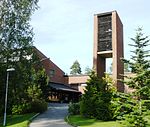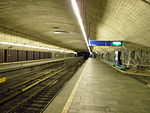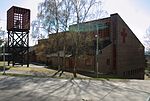Haugenstua Station
1937 establishments in NorwayRailway stations in OsloRailway stations on the Trunk LineRailway stations opened in 1937

Haugenstua Station (Norwegian: Haugenstua holdeplass) is a railway station on the Trunk Line located in the Haugenstua neighborhood of Oslo, Norway. Situated 12.09 kilometers (7.51 mi) from Oslo Central Station, it consists of two side platforms along a double tracked line and a disused station building. Haugenstua is served by the L1 line of the Norwegian State Railways's Oslo Commuter Rail. The station was opened on 1 December 1937 and received a major renovation in 2007. It has about 3,200 daily passengers.
Excerpt from the Wikipedia article Haugenstua Station (License: CC BY-SA 3.0, Authors, Images).Haugenstua Station
Haugenstuveien, Oslo Stovner
Geographical coordinates (GPS) Address External links Nearby Places Show on map
Geographical coordinates (GPS)
| Latitude | Longitude |
|---|---|
| N 59.951388888889 ° | E 10.908611111111 ° |
Address
Haugenstua (Haugenstua stasjon)
Haugenstuveien
1084 Oslo, Stovner
Norway
Open on Google Maps











